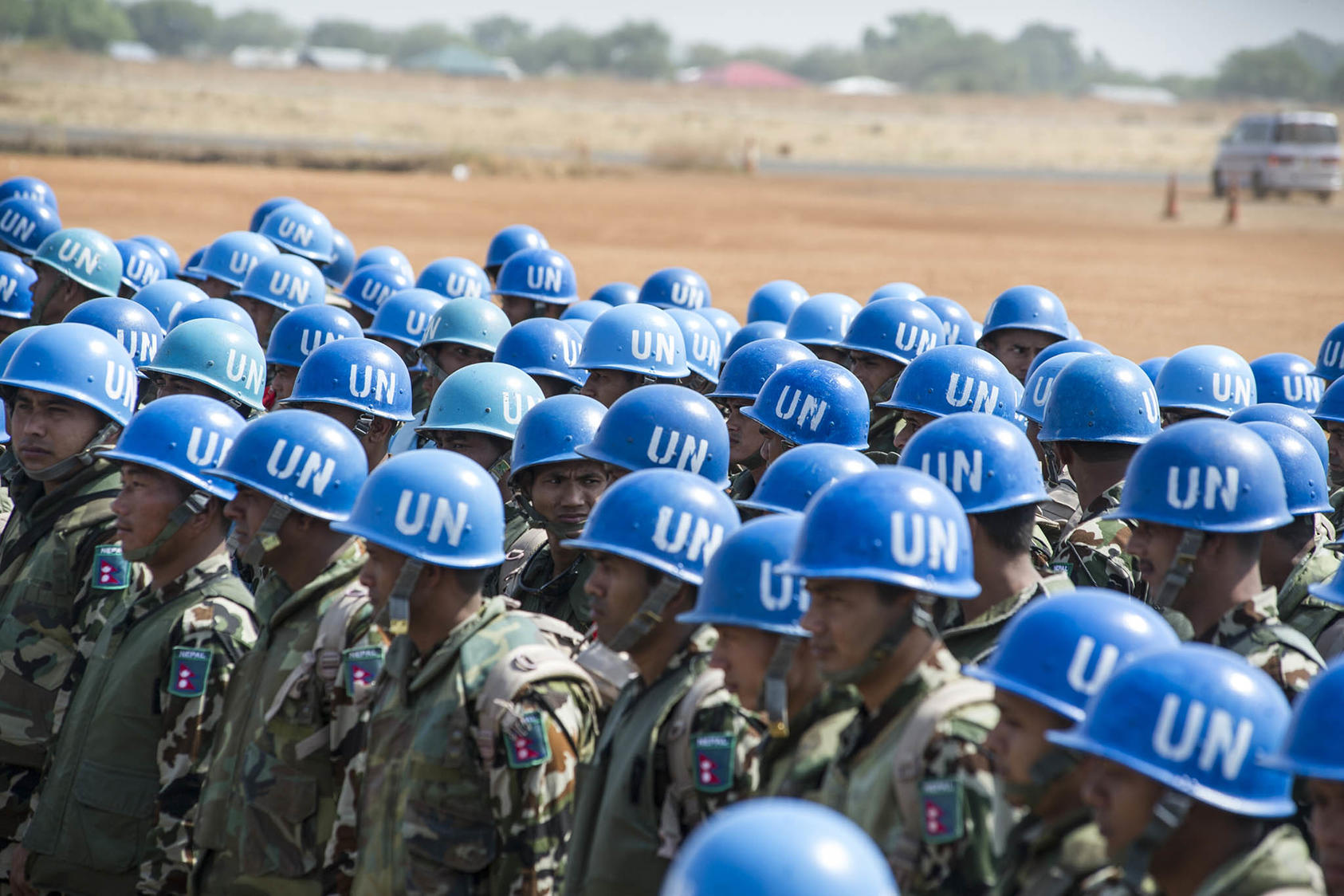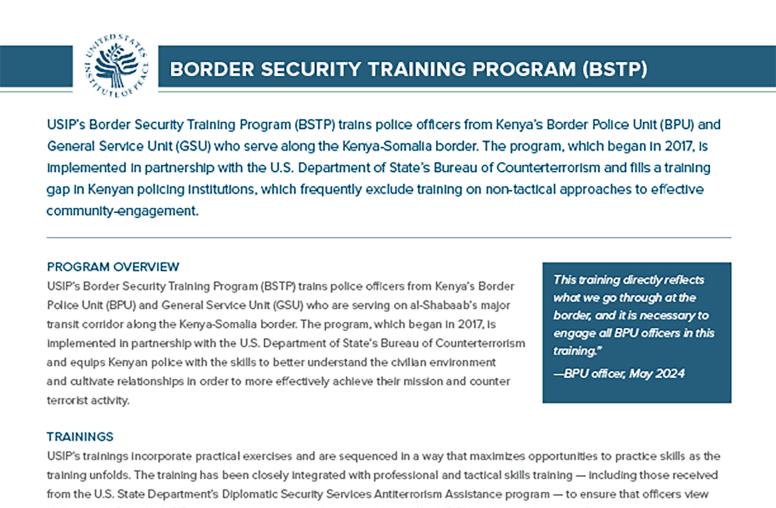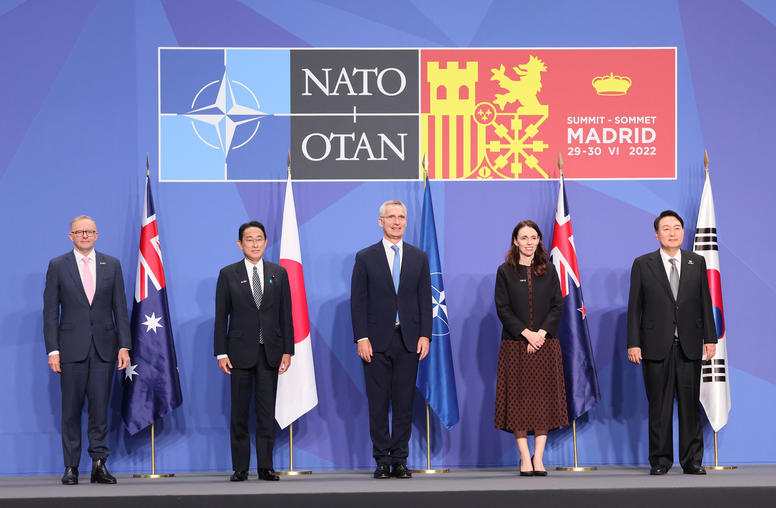What’s Next for the Blue Helmet 75 Years Later?
To fulfill their increasingly complex mandates, U.N. peacekeepers need the skills to build trust with vulnerable communities.
When the 1948 Arab-Israeli War ended in a cease-fire agreement, the international community recognized that an independent monitoring mechanism offered the best chance of maintaining the fragile peace process. And so, 75 years ago this week, the U.N. peacekeepers were deployed for the first time. Their mission in that conflict would become the template for U.N. peacekeeping operations for decades to come: Bringing stability to tenuous and uncertain post-conflict environments.

U.N. peacekeepers reflect an international desire to see peace processes succeed in thelong term. And their trademark blue helmets have become synonymous with a global commitment to protect civilians, provide life-saving humanitarian aid and secure an end to conflicts around the world.
However, the end of the Cold War marked a new era for U.N. peacekeeping. Their mandate was no longer limited to security and assistance — peacekeeping now meant everything from election monitoring to facilitating negotiations between belligerents. The environments that peacekeepers were deployed to shifted as well, with more missions in active combat zones than ever before. Today, peacekeepers are tasked with a vast array of responsibilities that far exceed those of their predecessors.
Unfortunately, the training given to U.N. peacekeepers has not kept up with these expanding mandates. Without a better understanding of the “soft skills” required to be a modern peacekeeper, U.N. peacekeeping is now plagued by a number of challenges that make their continued success increasingly difficult.
With the celebration of International Peacekeeper Day this week, this moment is an excellent opportunity for peacekeeping trainers to reflect on how they can prepare solutions that meet the persistent challenges of peacekeeping, from pre-deployment training to active mission.
Persistent Challenges
Peacekeepers are trained soldiers — often well-rehearsed and equipped with tactical gear, skills and protocols. However, some peacekeeping missions continue to struggle with community trust, which in turn leads to informational gaps that rebel groups utilize to their advantage. The tragic loss of life that can result among both peacekeepers and civilians is, as is the case with all wars, avoidable.
Peacekeeping mission effectiveness has also been tainted by multiple, recurring sexual exploitation and abuse incidents where peacekeepers have sometimes been directly implicated. Moreover, the intense nature of conflict environments puts troops under stress, adding one more layer of interpersonal conflict within the peacekeeping mission battalions themselves.
These different challenges chip away at mission effectiveness. To thrive and effectively fulfill their mandate to protect civilians, peacekeepers require an entirely different, complementary set of skills and dispositions that empower them to better assess needs and interests, build trust, communicate with care, and manage conflict nonviolently. The future well-being and safety of peacekeepers and the communities they protect depend on new training solutions to persistent training challenges.
"Soft” Skills are Core Skills
The key issue peacekeepers confront during complex missions, according to recently deployed MONUSCO troops who met with USIP during a workshop in Malawi, is the mistrust peacekeepers face from civilians. Troop deployments are usually brief, which makes deep community engagement and collaborative problem-solving between a new battalion and the community difficult and gives less time for trust-building. When troops are not empowered during pre-deployment with comprehensive training in what are often called “soft skills,” it becomes all the more difficult.
Since its introduction in the 1960s, this term has continued to mislead generations into thinking that little effort is needed to acquire these skills and, as a result, less time is assigned to training on skills such as communication, conflict analysis and management, and collaborative problem-solving.
Peacekeeping used to be associated with missions deploying to post-conflict contexts. Increasingly, however, more and more peacekeepers are sent to countries with active, on-going conflicts. This may tempt troop contributing countries’ (TCC) military training leadership to relegate these skills even further. Our experience, however, shows that the more complex the environment for peacekeepers, the more vital these soft skills become. Amid conflict, peacekeepers need to be able to deal with each other in a positive manner, and to access the vulnerable communities they are mandated to protect.
In one example, peacekeepers returning from a MONUSCO mission in the Democratic Republic of the Congo told USIP that they noticed Allied Democratic Forces rebels were broadcasting misinformation, claiming that the peacekeeping mission was intended to hurt civilians and not protect them. “Train and equip” initiatives would create more harm than good if they do not also train and equip peacekeepers with the interpersonal tools required to clearly and calmly explain their mandate and show an openness to listen to concerns and a willingness to engage in dialogue in order to combat this misinformation.
The most recurrent post-deployment lesson we hear from troops and military instructors is how important it is for every single soldier to receive training in nonviolent approaches to protecting civilians. That involves building their capacity to analyze conflict quickly and effectively (which is particularly important for brief deployments), to engage in dialogue, to negotiate and mediate, to better understand and explain their mission mandate, and to approach new cultural environments with humility.
This simple approach builds on self-reflection and the recognition that different cultures are not superior or inferior, creating the potential for a shift in mindset and disposition among peacekeepers that can help build trust and produce connections that saves lives. “Soft” skills are actually core skills, at the heart of saving the lives of civilians and peacekeepers alike.
Instructor-Centered Training Does Not Promote Learning
Over the past 15 years, USIP has trained nearly 10,000 peacekeepers from 24 countries and presided over the pedagogical committee of the International Association of Peacekeeping Centers to focus on learning innovations and best practice. Our in-depth assessment of training around nonviolent approaches to conflict management and protection of civilians for peacekeepers has revealed that it is crucial for peacekeeping training centers and organizations to revisit not only their training content to emphasize the value of communication skills and other nonviolent conflict management tools, but the approach to training delivery as well to ensure learning is successfully achieved.
The central issue is how pre-deployment training is designed by most TCCs. Though they try to follow the core pre-deployment training materials of the U.N., many TCC military instructors have not been exposed to shared, experiential learning approaches that are specifically designed for adult learners.
This is often because military training is designed to instill and reinforce military hierarchical dynamics. How we learn as adults, however, is heavily impacted by how much the experiences we come in with are valued and built upon in an interactive, collaborative environment that encourages critical engagement with and application of new concepts and frameworks. In the absence of awareness of how such learning can be perfectly calibrated to promote a creative, dynamic learning environment and preserve the required protocols and hierarchy, many military institutions stick to a traditional instructor-centric course format.
USIP has found that the very design of training delivery has to reflect the desired outcomes. If peacekeepers need to be able to quickly assess how to diffuse a conflict that involves civilians, they must be exposed to interactive, collaborative, problem-solving scenarios that help them make use of these new approaches to nonviolent conflict management. These scenarios should also be designed with a civilian lens to ensure that they realistically reflect the power dynamics and risks civilians experience when dealing with armed troops.
Talking at learners about the concepts without giving them an opportunity actually apply these interpersonal skills — just as they are given the opportunity to practice tactical maneuvers or evasive driving — does not promote the kind of learning that sticks. Practice and interaction in the pre-deployment training context allow for better application and an improved reaction time in-mission.
This is especially important when it comes to international human rights law. For peacekeepers to succeed in their missions, it’s not enough for them to just learn about the principles of international human rights law. They need to understand how to uphold those principles as part of their modus operandi when faced with situations that require quick decision-making in conflict zones.
Strengthening the Foundation
Peacekeeping missions have used troops from more than 100 countries across the globe, and these troops all come from national armies that have their own training strengths and deficiencies (which inevitably affect mission success). Transforming an individual from a national army soldier into a peacekeeper over the span of 12 weeks is not an easy feat given the amount of new mission-specific learning they have to acquire. Instructors at peacekeeper training centers also often offer training year-long in their national army training academies as well.
Peacekeeping missions’ success depends heavily on the quality of training peacekeepers receive, which in turn are impacted by the foundational training approaches and content they had been exposed to prior to becoming a peacekeeper. A serious commitment by the international community to support pedagogical capacity-building for TCC military instructors at the basic recruit training level is key to improving troop readiness at other levels.
Future of the Blue Helmet
Successful engagement with all actors in the peacekeeping mission would require peacekeepers to have well-developed cross-cultural skills, attitudes and dispositions that may seem at odds with traditional military training. However, the future of the blue helmet depends on the continuing effectiveness of peacekeeping missions, which, in increasingly complex conflicts, cannot be guaranteed without collaborative problem-solving, community engagement and nonviolent conflict management as well as a good understanding of mission mandates and human rights.
Ouiem Chettaoui is a senior program officer working on conflict management training for peacekeepers at USIP.
Gbenga Oni is a program officer with USIP’s curriculum and training design team.



